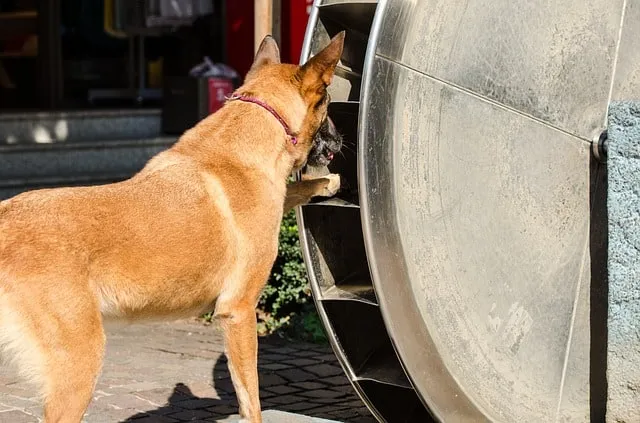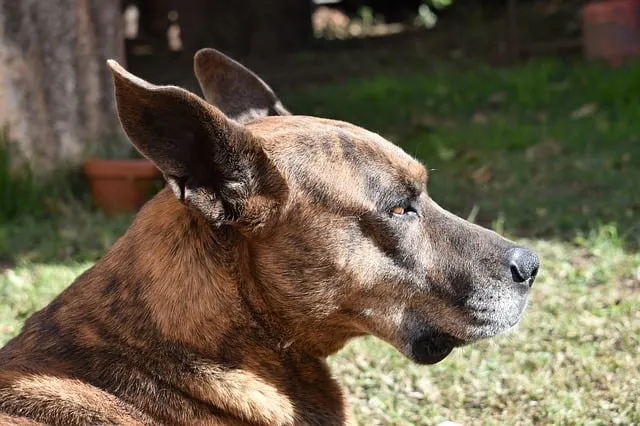The Belgian Malinois is an athletic and energetic breed and although their appearance is somewhat similar to the German shepherd, they give off a look of elegance, as they are finer-boned. The Malinois coat can range from fawn to rich mahogany being a shiny, short double coat.
The Belgian Malinois generally has a healthy coat which also shows that their skin is healthy as well, but Belgian Malinois, just like other breeds, can be prone to various skin problems and conditions.
Many skin ailments are easily diagnosed and remedied, while others may take a bit of detective work. Oftentimes issues are due to allergies.
The following post contains information on Belgian Malinois skin allergies and other conditions as well as symptoms and treatment.

For your dog’s vitamin supplement, food, toys, or other dogs product please visit the Sundays for dogs website.
Belgian Malinois Skin Problems Symptoms and Treatment
Skin problems and issues can crop up in both dogs and humans and often it is difficult to determine a cause.
Some rashes have a certain appearance and it’s easy for your pup’s veterinarian to give a clear-cut diagnosis, but other times much more investigation is required.
Some skin conditions are curable, meaning that medications, lifestyle changes, or treatments will be the total cure.
Other skin issues may be incurable, often caused by an underlying medical condition or autoimmune disease.
In this case, courses of treatment are offered and will be ongoing to relieve symptoms or medication for a certain disease will eliminate skin issues.
Following are some skin conditions that can plague your Belgian Malinois.
Allergic Dermatitis
Dermatitis is redness and itchiness, characterized by a rash with skin inflammation. Allergic dermatitis, therefore, is a skin rash caused by allergies and this can become a very complex problem in determining what allergen is producing symptoms.
Belgian Malinois skin allergies may cause constant scratching, which produces a red inflamed, and sometimes an oozing rash on paws, ears, armpits, groin, underbelly, and between toes. Symptoms are scratching, licking, and biting and may be accompanied by watery eyes and sneezing.
Causes of allergic dermatitis can be plants, pollen, grooming products, food, or medications. To control or cure this, a change in food may be necessary, or even allergy medication.
Medicated or hypoallergenic shampoo can be used to soothe but should be rinsed very well so as not to irritate further. Steroid creams, lotion, or a short period of oral steroids may be prescribed.
If the allergy is caused by food, the cure may be as simple as changing the diet. For environmental allergens, ongoing treatment may be needed.
To check your Belgian Malinois health status or their DNA, please visit the Embark vet website for all the help you may need.

Dog dry skin
Dry skin often becomes itchy and flaky, leading to scratching. Constant scratching can eventually lead to infection so it’s best to try and get to the root of the problem swiftly to treat it.
Your Belgian Malinois’s dry skin may be a combo of cold weather and dry heat in your home.
Bathing with an oatmeal shampoo can help calm and rehydrate skin but you don’t want to bathe too often either or it will strip away necessary skin oils.
Adding a humidifier, in the winter months can benefit everyone.
Lastly, make sure your pup’s food and diet contain all of the essential vitamins, minerals, and supplements for healthy skin and coat.
Speak with your veterinarian about adding omega-3 supplements. Also be aware that some diseases like hypothyroidism can cause dry, itchy skin and rashes, especially if dry skin continues into summer.
Bacterial infections
Scratching and itching from many causes can lead to scabs and sores and in turn, a bacterial infection. Two of these are listed below.
- Impetigo
Impetigo – This is usually found in puppies and exhibits symptoms of pus-filled blisters that will burst and scab over.
It is usually found on skin with little furs, like the abdomen. Even though the look of it causes alarm, it is not a serious issue.
It is generally caused by the staphylococcus bacteria and can be treated with a combination of antibiotics, topical ointments, and medicated shampoo. Often, it does clear on its own, but otherwise, it can spread if not treated.
- Folliculitis
Folliculitis – This is another bacterial infection with symptoms of scabs and sores and can be caused by scratching from allergies, dry skin, etc.
Treatment is usually an antimicrobial drug that kills and stops the growth of microorganisms, topical creams, and also treatment for an underlying medical condition if need be.
Yeast infection
This presents as an itchy rash, especially on paws and ears with skin discoloration. These infections are more common in the summer and usually emit a bad odor.
Yeast infections can be treated with medicated shampoos, topical ointments, and sometimes oral medication. A high-carb diet can also contribute to the growth of yeast from sugars found in carbohydrates.
Parasites
Parasitic infections can also cause an allergic reaction leading to infection. Fleas, ticks, and mites are the three big offenders.
- Fleas
Fleas are quite common in dogs. Prevention is key before fleas get the upper hand and you have a full-blown infestation both on your Belgian Malinois and in your home.
Fleas can cause uncontrollable scratching and can also lead to an infection. Prevention, using topical liquid drops, pills, or flea collars is needed, especially if your Belgian is outdoors frequently, in warm weather.
Check your pup often for fleas, wash their bedding often and vacuum your house regularly.
If you suspect your Belgian Malinois may have fleas, use a flea treatment that kills both larvae and adult fleas.
You will have to treat your home as well. Consult your veterinarian if you have questions about products and safety.
- Ticks
Ticks are very concerning as they not only feed on the blood of the host but they can cause Lyme disease as well as other tick-borne illnesses and bacterial infections.
Prevention again is key, and most flea preventatives kill both fleas and ticks. Again, after outdoor adventures, check your pup for ticks.
The only treatment to finding a tick is by removing it. in this case, consult your veterinarian for a proper procedure.
- Mites
Mites are a parasite that can cause mange, which is not contagious and sarcoptic mange, which is contagious and can spread quite easily.
Both cause itching, red irritated skin, sores, and bald patches. The only prevention is to keep your pup away from other infected dogs. Treatment is usually topical, oral, or a combination of medications and medicated baths.

Ringworm
Ringworm’s telling symptom is a “ring-like” lesion with patches of scaly skin and loss of fur. Ringworm is not caused by the worm-like name implies but is a type of fungus mostly found in puppies. It can spread swiftly.
Prevention is no contact with other infected puppies and is more commonly found in animal shelters and pet stores, although it can be found at breeding facilities that are less reputable.
Treatment will involve a combination of oral and topical medications as well as bathing.
Alopecia
Your Belgian Malinois will “blow” its coat twice a year, signaled by excessive shedding. This is normal, but excessive shedding at other times of the year may be a sign of alopecia, especially if your pup has bald patches.
Alopecia can be caused by all of the above issues, allergies, infections, and parasites but also lack of proper nutrients, stress, or an underlying disorder that can be genetic in nature.
Treatment depends on the cause and can be antibiotics, topical ointments, proper nutrients in the form of supplements, or treating an underlying medical condition or disease.
Your Belgian Malinois is definitely not prone to skin problems but the issues listed above are common to all breeds. Weather conditions, parasites, and underlying diseases play a role in the cause of various skin conditions.
Always consult your veterinarian when skin issues crop up. Getting a definitive diagnosis, if possible, is the best course.
Your pup may need to see a dermatologic veterinarian if there is a question as to the cause of skin issues.
Overuse of cortisone and steroids are not good either. They are just a band-aid, temporarily clearing the problem but not curing it.
Use caution, also when using flea and tick medications. Although necessary, most contain pesticides.
A healthy diet and exercise should keep your Belgian Malinois with clear skin and a shiny coat but when in doubt, seek out the advice of a professional.